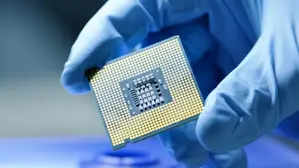[ad_1]

NEW DELHI: The development of a semiconductor unit in Morigaon, Assam, spearheaded by Tata Semiconductor Assembly and Test Pvt Ltd (TSAT) with an investment of ₹27,000 crore is headed for completion in mid-2025, will be a game-changer for India’s semiconductor ecosystem, the Ministry of Electronics & IT said on Sunday.
The Morigaon facility is expected to produce up to 48 million semiconductor chips per day, employing advanced packaging technologies like flip chip and Integrated System in Package (ISIP).
Designed to cater to essential sectors such as automotive, electric vehicles, telecommunications, and consumer electronics, the project is set to become one of the country’s premier manufacturing sites. It aligns with the nation’s broader goal of establishing a self-sufficient semiconductor ecosystem.
The Morigaon unit goes beyond technological development, it brings significant socio-economic benefits by generating 15,000 direct and 11,000-13,000 indirect jobs, contributing to regional economic growth in Assam and nearby areas.
As a high-capacity production site, the facility’s daily output will serve both domestic and international markets, positioning India as a competitive force in the global semiconductor supply chain, the statement said.
Industry estimates place the Indian semiconductor market at approximately $38 billion in 2023, with projections indicating growth to $109 billion by 2030. To support this rapid expansion and reduce reliance on imports, the Indian government has implemented several initiatives aimed at promoting domestic semiconductor manufacturing.
The India Semiconductor Mission (ISM) aims to build a sustainable semiconductor and display ecosystem that will position India as a leader in electronics manufacturing and design.
Guided by international semiconductor experts, ISM coordinates efforts across government ministries, industry, and academic institutions to ensure efficient deployment of resources and support.
Launched in 2021 with a financial outlay of ₹76,000 crore, the Semicon India program is structured to promote the domestic semiconductor industry through incentives and strategic partnerships. This initiative supports various sectors of the semiconductor industry, extending beyond just fabrication facilities (fabs) to include packaging, display wires, Outsourced Semiconductor Assembly and Testing (OSATs), sensors, and other critical components, creating a comprehensive ecosystem.
Under the program, four schemes have been introduced namely the Modified Scheme for setting up Semiconductor Fabs in India, the Modified Scheme for setting up Display Fabs in India, the Modified Scheme for setting up Compound Semiconductors/ Silicon Photonics/ Sensors Fab/ Discrete Semiconductors Fab and Semiconductor ATMP/ OSAT facilities in India, and Design Linked Incentive (DLI) Scheme.
The Morigaon semiconductor facility is part of a wider network of government-backed projects aimed at bolstering India’s semiconductor production capabilities.
The Union Cabinet has approved the establishment of multiple semiconductor units across the nation, including new facilities by Tata Electronics in Dholera, Gujarat, and CG Power in Sanand, Gujarat.
Additionally, Kaynes Semicon Pvt Ltd was approved to set up a unit in Sanand as well. This expansion signifies India’s commitment to reducing reliance on semiconductor imports and fortifying its position in the global semiconductor value chain.
The government has also focused on modernizing the Semi-Conductor Laboratory in Mohali and implementing the Scheme for Promotion of Manufacturing of Electronic Components and Semiconductors (SPECS) and the Production Linked Incentive (PLI) Scheme for Large-Scale Electronics. These efforts ensure support for every segment of semiconductor production, fostering an ecosystem that encompasses chip design, fabrication, testing, and assembly.
As the demand for semiconductors surges worldwide, India’s burgeoning semiconductor infrastructure is set to drive innovation, create jobs, and secure the country’s position as a significant player in the global digital economy, the statement added.
[ad_2]
Source link



